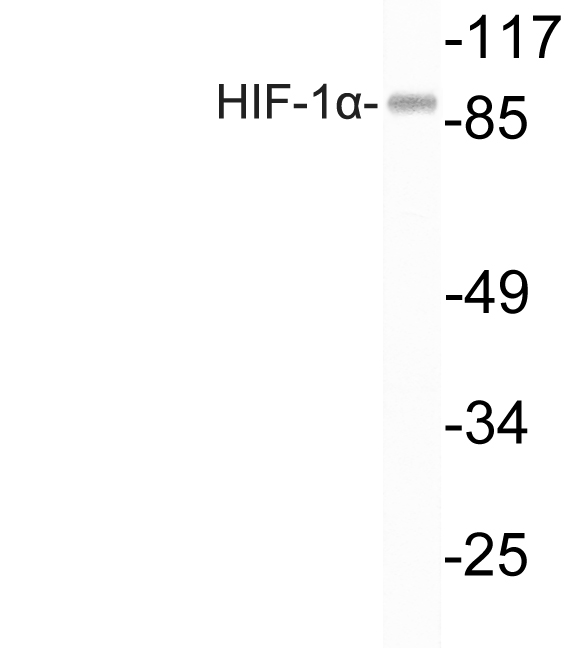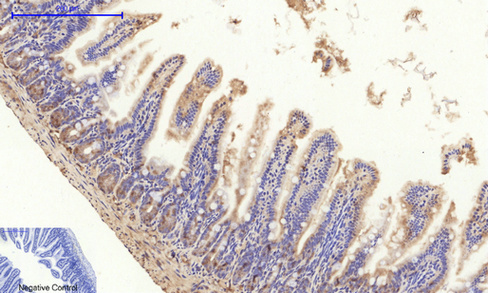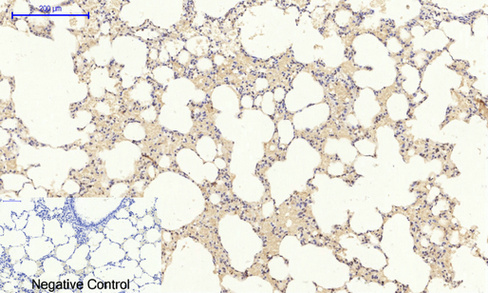


| WB | 咨询技术 | Human,Mouse,Rat |
| IF | 咨询技术 | Human,Mouse,Rat |
| IHC | 1/50-1/100 | Human,Mouse,Rat |
| ICC | 1/50-1/200 | Human,Mouse,Rat |
| FCM | 咨询技术 | Human,Mouse,Rat |
| Elisa | 1/10000 | Human,Mouse,Rat |
| Aliases | HIF1A; BHLHE78; MOP1; PASD8; Hypoxia-inducible factor 1-alpha; HIF-1-alpha; HIF1-alpha; ARNT-interacting protein; Basic-helix-loop-helix-PAS protein MOP1; Class E basic helix-loop-helix protein 78; bHLHe78; Member of PAS protein 1; PAS doma |
| Entrez GeneID | 3091 |
| WB Predicted band size | Calculated MW: 93 kDa; Observed MW: 92-130 kDa |
| Host/Isotype | Rabbit IgG |
| Antibody Type | Primary antibody |
| Storage | Store at 4°C short term. Aliquot and store at -20°C long term. Avoid freeze/thaw cycles. |
| Species Reactivity | Human,Mouse,Rat |
| Immunogen | The antiserum was produced against synthesized peptide derived from human HIF-1alpha. AA range:328-377 |
| Formulation | Purified antibody in PBS with 0.05% sodium azide,0.5%BSA and 50% glycerol. |
+ +
以下是关于HIF-1α抗体的3篇参考文献的简要概括:
1. **文献名称**:*Targeting HIF-1α for cancer therapy*
**作者**:Semenza, G.L.
**摘要**:该综述总结了HIF-1α在肿瘤发生中的核心作用,并讨论了使用特异性抗体(如免疫组化和Western blot分析)检测HIF-1α表达的策略,以及基于HIF-1α靶向的癌症治疗进展。
2. **文献名称**:*HIF-1α modulates energy metabolism in cancer cells by inducing M2-like macrophage polarization*
**作者**:Wang, Y. et al.
**摘要**:本研究通过HIF-1α抗体(ChIP实验和免疫荧光)证实了HIF-1α在肿瘤微环境中调控巨噬细胞代谢重编程的机制,揭示了其促进肿瘤免疫逃逸的新通路。
3. **文献名称**:*Regulation of hypoxia-inducible factor 1α by the ubiquitin-proteasome pathway*
**作者**:Ruas, J.L., Poellinger, L.
**摘要**:文章利用HIF-1α特异性抗体(Western blot和免疫沉淀)揭示了缺氧条件下HIF-1α蛋白的泛素化降解机制,为靶向HIF-1α稳定性的药物开发提供理论依据。
注:以上文献信息为示例性概括,实际引用时需核对具体文献来源及细节。
HIF1 alpha (hypoxia-inducible factor 1-alpha) is a critical transcription factor that regulates cellular responses to hypoxia. Under normoxic conditions, HIF1 alpha is rapidly degraded by the ubiquitin-proteasome system due to prolyl hydroxylation and subsequent binding of the von Hippel-Lindau (VHL) protein. However, hypoxia stabilizes HIF1 alpha, allowing it to dimerize with HIF1 beta and activate target genes involved in angiogenesis, glycolysis, and cell survival (e.g., VEGF, EPO, and GLUT1).
HIF1 alpha antibodies are essential tools for detecting and quantifying HIF1 alpha protein levels in research. They are widely used in techniques like Western blotting, immunohistochemistry (IHC), immunofluorescence (IF), and chromatin immunoprecipitation (ChIP) to study hypoxia-related pathways. These antibodies help elucidate HIF1 alpha's role in diseases such as cancer (tumor angiogenesis), ischemic disorders, and inflammatory conditions. Specificity is critical, as cross-reactivity with other HIF isoforms (e.g., HIF2 alpha) can lead to misinterpretation. Researchers often validate antibodies using knockout cell lines or siRNA-mediated knockdown. Commercial HIF1 alpha antibodies are typically raised against conserved epitopes in the N-terminal or C-terminal regions. Monoclonal antibodies offer high specificity, while polyclonal versions may provide higher sensitivity. Proper controls, including hypoxia-mimetic agents (e.g., CoCl2) for inducing HIF1 alpha, are recommended in experimental designs.
×